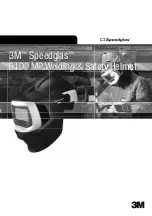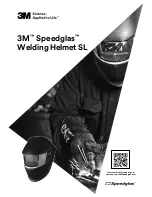
EN 397
EN 166
EN 170
EN 50365
IEC 61482
UK
INSTRUCTION MANUAL FOR
HELMET WITH ARCFLASH PROTECTION
MO-180-ARC4
MO-180-ARC12
This manual must be read carefully both by the individuals
who wear the helmet and by those responsible for its
maintenance. Keep this manual, because it represents,
together with the purchase invoice, the guarantee for the
helmet.
These are the instructions for the use and maintenance of the
MO-180-ARC(4)(12) helmet. It is our hope that the product will
meet your needs and prove to be of use for many years.
A great deal of attention has been paid to the text and
illust
rations in this user’s manual. Nevertheless, the publisher
cannot be held liable for any errors or for their consequences.
Suggestions regarding the product and its manual can be
presented to our company, which shall take them into account,
should they result in concrete improvements.
CATU reserves the right to modify, even without advance
notification, both the product and its accessories, as well as
their technical characteristics.
The companies, brands and products mentioned all represent
registered or pending trademarks or titles.
I PERFORMANCE
The performance characteristics for which the helmet has
been designed are guaranteed only if it is used correctly and if
maintenance is performed as described in the instructions.
Should this not be the case, then the protective features
cannot be guaranteed.
The guarantees provided by CATU with regard to this product
shall be null and void should the warnings, precautions and
instructions contained in the present manual not be followed.
After reading the manual, should you still have any doubts
regarding the level of protection offered by the helmet, the
conditions for its use or the maintenance procedures, feel free
to contact us at the numbers indicated.
II - WARNINGS
Failure to respect the warnings listed below could have grave,
and even life-threatening, consequences.
This helmet is designed to provide protection from impact,
from penetration from above, from crushing, from tension and
from exposure to flames, within the limits contemplated under
the EN 397 Norms.
It is meant to reduce the effects of unforeseen events, but it
cannot protect the head from all eventualities.
To ensure maximum protection, the helmet:
MUST
be properly placed on the head, and the
webbing must be adjusted to ensure that the helmet fits
snugly, through with a certain degree of comfort.
To ensure maximum stability of the helmet, always
attach and adjust the chin-strap correctly; this will help
reduce shifting of the helmet resulting from certain
environmental conditions.
Do not place any outside objects between the padding
and the parts of the helmet beneath it, given that such
objects, in the event of an impact, can transmit
significant force to the head, with serious, potentially
life-threatening consequences.
NEVER USE
this helmet for driving or for sports
activities.
Inspect the helmet before and after each use,
employing the inspection procedures described in this
manual and immediately replacing any worn or
damaged parts exclusively with spare parts supplied by
CATU.
NEVER
alter or modify the helmet.
NEVER
attach accessories and/or decals or labels
within 26 mm of the edge of the head-piece. Any
modifications or any utilisation of accessories other
than those supplied by CATU may reduce the levels of
protection or the dielectric properties.
NEVER
use paints, solvents or detergents made from
hydrocarbons on this helmet. Such substances can
damage the materials in a manner not visible to the
eye, reducing their protective properties.
Hazards Assessment
The user must perform a Hazard Risk Assessment to
determine the level of exposure and need. This task
can be accomplished with the proper training and
software. According to this Hazard Risk Assessment,
the CATU Helmet shall be combined with further arc
flash protective PPE such as garments, gloves, etc.
Limitations - Warning
Failure to follow these instructions can result in a
permanent impairment of sight or other serious
personal injury.
III - HELMET FEATURES
1. Precautions
This helmet
MUST
be kept in a clean, dry, dark spot, not near
sources of heat, and at a constant temperature of between
+10° and +40°.
The helmet should be washed with lukewarm water
and neutral soap.
NEVER
keep the helmet inside the vehicle when not
being used. Not only will it be exposed to sunlight (UV
rays and heat), but, if not adequately set in place, it
could also be thrown about inside the vehicle in the
event of a sudden stop.
2. Sharp impact
Following a sharp impact or stress, the helmet should not be
used again. Internal breakage which cannot be seen could
decrease resistance to subsequent impacts. Should you have
any doubts, do not hesitate to contact CATU.
3. Chemical agents
All chemical products, corrosive substances and solvents
could, in certain concentrations, prove dangerous for this
product. If it is possible or necessary for your helmet to come
into contact with such substances, consult CATU, indicating
the name or the compound, and you will be given an
appropriate response following careful study of the specific
case.
4. Disinfecting procedure
Should it be necessary to disinfect the helmet, use only
products compatible with the following materials: Polyamide,
Polycarbonate, Nylon 6, ABS.
Immerse the helmet in a solution containing 80% water, at a
temperature of approximately 20° C for roughly 1 hour. Then
rinse the helmet with running water and leave it to dry.
5. Lifetime
Helmet maximum recommended duration of use is 5 years.
This lifetime is only a recommendation, it depends on the use
and storage. (For the visor see §VISOR FOR ARCFLASH
PROTECTION)
6. Maintenance
Clean the helmet according to the following procedures:
1
st
)
Dismantle the helmet.
2
nd
) Clean all the pieces inside and outside, using only
neutral soap and lukewarm water, with the exception of
the following pieces:
Wash the head-piece with cold water and neutral soap.
Do not use solvents; leave to dry at room temperature.
Wash the visor with lukewarm water; dry using a soft
cloth that does not scratch the surface.


























